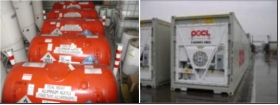DG transportation

Our service
We promise overnight response to any DG inquiry on both the ocean freight and space availability. We feed customers with the highest level of DG information and compliance for the transportation of hazardous materials. Our specially trained staff constantly stays abreast of international, national, and even local regulations affecting the transportation of hazardous cargo. Our trained staff will provide you with professional service.
Relevant Laws and Regulations
The Carriage of dangerous goods and marine pollutants in sea-going ships is respectively regulated in the International Convention for the Safety of the Life at Sea (SOLAS 74) Chapter VII and the International Convention for the Prevention of pollution from Ships (MARPOL 73/78).
Relevant parts of both SOLAS and MARPOL have been worked out in great detail and are included in the International Maritime Dangerous Goods (IMDG) Code, thus making this Code the legal instrument for maritime transport of dangerous goods and marine pollutants. As of 1st January 2004, the IMDG Code 2002 Amendment 31 has become a mandatory requirement. Meanwhile, All package, labels, stowage and others of the dangerous cargo must be strictly in accordance with relevant requirement written by government of export and import country and in IMDG CODE.
DG Grade
The carriage of DG goods must be conducted under strict regulation and control in regards of her physical and chemical characteristics. Hence carriers, shipping owners, the Customs and international organizations all release various regulations on the transportation security. All relevant parties need close team work which results in a complicated DG operation procedure.
IMDG works as the international marine regulation on DG goods setup category like:
Grade one: Explosion goods
Grade two: Gases
Grade three: inflammable fluid
Grade four: inflammable solid, self- inflammable material, substances which, in contact with water, emit inflammable gases
Grade five: Oxidant and Organic peroxides
Grade six: Toxic and infectious substances
Grade seven: Radioactive material
Grade eight: Corrosion products
Grade nine: Miscellaneous dangerous substances and articles
Necessary Document
In order to check easily by relevant parties and get quick reply by return, shipper should to provide the same as described in its customs declaration documents. If possible, please include below contents:
i. Shipping orders (indicating commodity names in both Chinese and English, Number of Packages, Net/Gross Weight, Packing type, IMO class, UN Number)
ii. CARGO PROPER SHIPPING NAME
iii. TYPE AND SORT OF INNER PACKING
iv. SIZE AND NUMBER OF CONTAINER
v. IMO CLASS
vi. UN NUMBER
vii. SUBSIDIARY LABEL
viii. PLACE OF RECEIPT CARGO
ix. PORT OF LOADING
x. PORT OF TRANSHIPMENT
xi. PORT OF DESTINATION
xii. PLACE OF DELIVERY
xiii. GROSS WEIGHT (Kgs)
xiv. NET WEIGHT (Kgs)
xv. PACKAGE GROUND
xvi. FLASH POINT (Flammable Liquid)
xvii. MARINE POLLUANT
xviii. MPA GROUP
xix. MSDS ( Material Safety Data Sheet)

